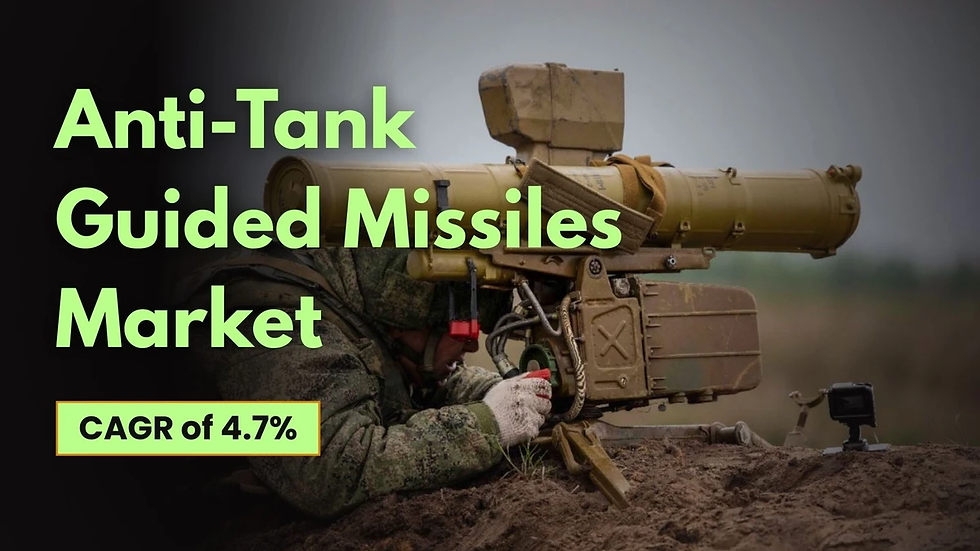Anti-Tank Guided Missiles Market Insights, Size, Share, and Forecast, 2025–2032
- Rishika Chavan
- Aug 13
- 3 min read
According to Fortune Business Insights™, the global anti-tank guided missiles market is on a steady growth trajectory, with valuations climbing from USD 388.2 million in 2025 to an estimated USD 535.2 million by 2032, reflecting a 4.7% CAGR.
The sector, anchored in the development and deployment of precision missile systems designed to neutralize armored threats, is riding a wave of defense spending hikes, battlefield modernization, and AI-powered targeting innovations. These weapons ranging from man-portable launchers to airborne long-range strike systems are a central pillar in modern military strategies worldwide.
“ATGMs are no longer just tank killers they are multi-role, networked assets integrated into the wider digital battlefield,” said a defense analyst familiar with NATO procurement programs.

Drivers: Modernization Meets Geopolitical Urgency
Defense ministries across the globe are prioritizing upgrades to their armored and infantry capabilities, especially in conflict-sensitive regions. The U.S., Europe, and parts of Asia are accelerating procurement programs to deploy next-generation ATGMs with enhanced accuracy, longer ranges, and resilience against countermeasures.
The integration of artificial intelligence, fire-and-forget technology, and sensor fusion is transforming engagement speed and precision. These systems are increasingly designed to connect with drones, command centers, and battlefield management platforms for coordinated strikes.
Restraints and Challenges
A key challenge lies in the rapid evolution of countermeasure technologies, such as Active Protection Systems (APS), which can intercept and destroy incoming missiles. This forces ATGM manufacturers to constantly innovate — a costly and time-intensive process.
Budgetary pressures also limit adoption in emerging economies. Cutting-edge systems can strain procurement budgets, particularly for smaller nations balancing multiple defense priorities.
Information Source:
Trends: Portable Systems Take the Lead
Man-portable ATGMs accounted for 46.89% of market share in 2024, offering frontline units a lightweight, cost-effective, and highly mobile solution. Systems like the U.S.-made Javelin and the U.K.-Swedish NLAW have shown battlefield success in recent conflicts.
Meanwhile, airborne ATGMs are emerging as the fastest-growing segment (5.2% CAGR), providing rapid deployment and safe standoff engagement from helicopters and UAVs.
Regional Outlook
North America remains the innovation hub, with Lockheed Martin and Raytheon spearheading advanced designs.
Europe is ramping up procurement under NATO modernization initiatives, with MBDA and Rheinmetall at the forefront.
Asia-Pacific is the fastest-growing region, led by India, China, and South Korea, driven by border tensions and regional security concerns.
Middle East & Africa are increasing procurement of cost-effective systems to strengthen internal and regional defense capabilities.
KEY INDUSTRY PLAYERS
Key Players Focus on Technological Advancements to Propel Market Growth
According to Fortune Business Insights™, the global anti-tank guided missiles (ATGM) market is led by prominent companies such as MBDA, Rafael Advanced Defense Systems, and Lockheed Martin, which continue to push the boundaries of innovation and technological advancement. Other significant players, including Kongsberg Defense & Aerospace, Northrop Grumman, and Denel Dynamics, are also making strides in delivering advanced missile systems tailored to evolving defense requirements.
These market leaders are heavily investing in the development of lightweight, highly accurate, and versatile ATGMs that can neutralize modern armored threats. The competitive landscape is shaped by rising defense budgets, technological breakthroughs, and the growing need for enhanced battlefield survivability, positioning these players at the forefront of the industry.
List of Key Anti-Tank Guided Missile Companies Profiled
Raytheon Technologies Corporation (U.S.)
Lockheed Martin Corporation (U.S.)
MBDA (France)
Rafael Advanced Defense Systems Ltd. (Israel)
KBP Instrument Design Bureau (Russia)
Norinco (China)
Roketsan (Turkey)
Saab AB (Sweden)
LIG Nex 1 (South Korea)
Bharat Dynamics Ltd. (India)
NPO Mashinostroyeniya (Russia)
Denel Dynamics (South Africa)
Mesko (Poland)
Aselsan (Turkey)
BAE Systems plc (U.K.)
Recent Developments
In March 2025, India’s Ministry of Defence signed contracts with Armoured Vehicles Nigam Limited for the tracked Nag Missile System, while also securing deals with Force Motors and Mahindra & Mahindra for 5,000 light vehicles for military use — signaling the country’s growing focus on indigenous defense production.



Comments